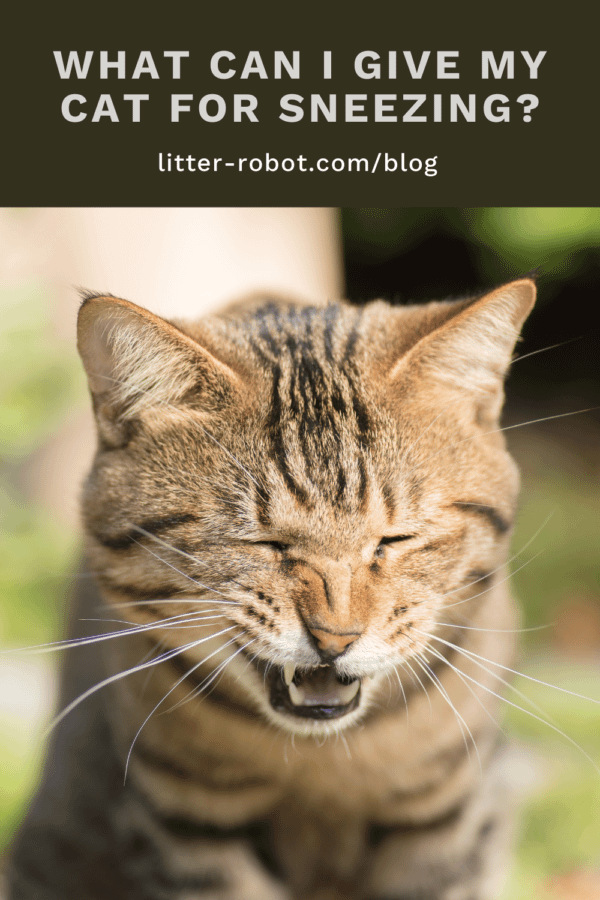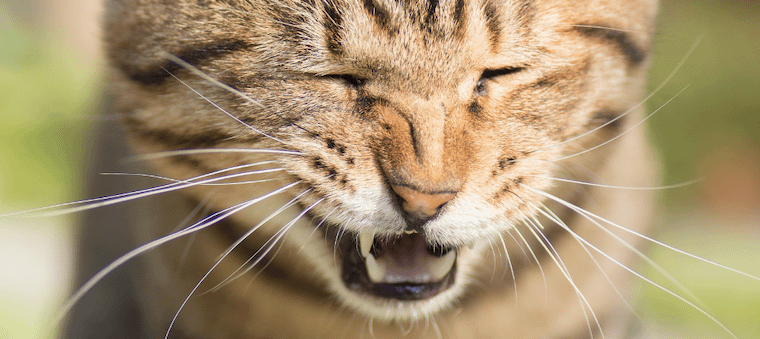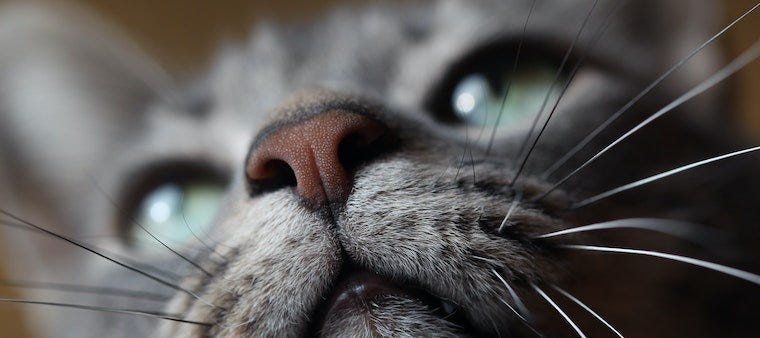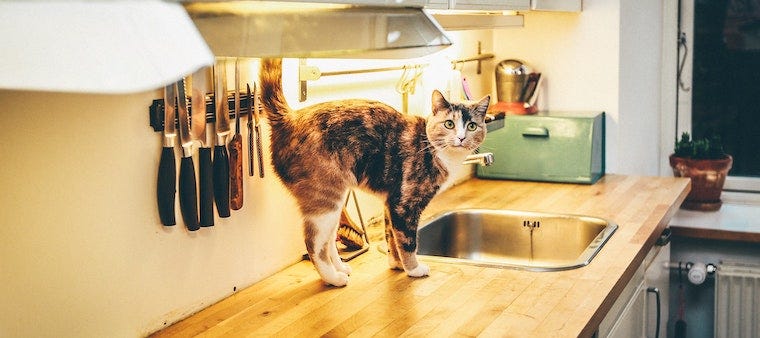Wondering what you can give your cat for sneezing? A myriad of issues can cause your cat’s sneezing. In fact, sometimes sneezing isn’t sneezing at all. Your cat could be hiccuping, gagging, coughing, wheezing, or retching. These are all symptoms that can be misidentified as sneezing, all of which have their own set of causes.
Once you get to the root cause of the situation, you’ll be able to help treat your cat's sneezing. Read on to determine the reasons why your cat could be sneezing and how to provide the relief your cat needs.
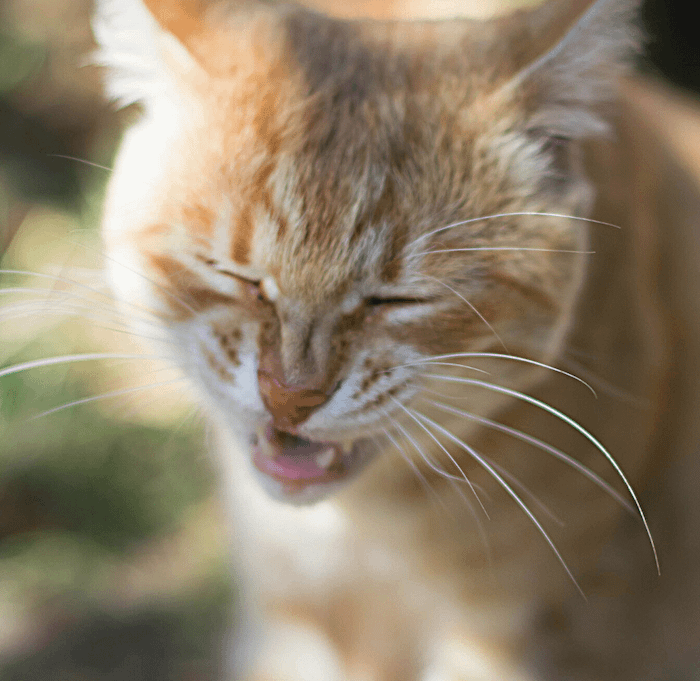
Is cat sneezing serious?
Sneezing on occasion is nothing to worry about. Humans don’t run to the doctor every time they sneeze, so you should use yourself as a gauge to determine when it’s time to worry. However, if your cat is sneezing excessively or having a hard time breathing, it’s time to schedule a trip to the vet.
Before you visit the vet, take a video of your cat sneezing. After all, your cat won’t likely sneeze on command during the exam. A video will allow your vet to review the sneeze while they examine your cat.
What causes cat sneezing?
Not all sneezing is the result of a cat viral infection. Instead, sneezing is often a symptom of different ailments. If you’re wondering why your cat is sneezing so much, one of the following reasons might be to blame:
- Viral infection
- Ear or nasal mites
- Chronic upper respiratory infection
- Fungal infection
- Hay fever
- Dental disease
- Neoplasia or tumors
- Allergies
- Inhalation of foreign material
- Bacterial infections
- Inflammation and irritation
Many of these issues can be exacerbated by dirt, dander, or bacteria. It’s highly recommended that you keep your cat’s litter box, feeding area, and furniture clean by using a pet-safe cleaner spray or wipes.
How will the vet determine why my cat is sneezing?
You will need to reach out to a vet to thoroughly assess your cat and his or her sneezing behavior. There’s no easy way to determine what is causing your cat's nose to be irritated without the help of a professional. During your visit to the vet, the medical care team will be able to provide you with solutions that help you get your cat a proper diagnosis and treatment.
Physical Exam
First things first, your vet will physically examine your cat. This is an opportune time to let your vet view sneezing videos that you were able to capture and provide a list of any other symptoms you might have noticed, like loss of appetite or eye discharge.
Be sure to inform your veterinarian about how long the sneezing has been going on and note any nasal discharge you’ve noticed. Your veterinarian will then provide your cat with a thorough exam. This will include checking your cat's ears, nose, throat, heart, and lungs.
During the exam, there may be clues that provide your vet with further insight into why your cat is sneezing. After the physical exam, your vet might take a culture to determine if any infections are at play and identify if any foreign bacteria are present.
It’s important to note that the nasal cavity is not a sterile location. If any bacteria is found, it might not automatically prove to be the primary cause of your cat’s sneezing. Your vet will want to ensure no other disease or condition is causing the sneezing by conducting further testing.
Imaging
The reason your cat is sneezing might not immediately present itself, at least not without imaging that can confirm the primary cause. That’s why the gold standard of imaging for a cat is a computerized tomography (CT).
During a CT scan, your cat will be placed under general anesthesia. This heavy sedation ensures that your cat remains still throughout the entire duration of the scan to get high-quality radiographs. The images allow the vet to check the nasal passages’ architecture, the oral cavity, and the sinus cavities for lesions, masses, foreign materials, or granulomas.
Most vet offices do not have the ability to complete CT scans directly on-site. They will often refer you to a local emergency clinic or hospital to complete the test instead.
Rhinoscopy
A rhinoscopy for cats is a technique that allows vets to see directly inside your cat's nasal passages. During a rhinoscopy, biopsies of specific areas can be taken and any foreign bodies can be removed.
A rhinoscopy is done under sedation. A small, flexible scope will be inserted into your cat's nasal cavities. There will be a constant saline flush running throughout the duration of the procedure. After the rhinoscopy, nasal congestion and bleeding are normal.
Biopsy
During a rhinoscopy or after a CT scan for cats, a biopsy might be taken if a mass is found. A biopsy is typically performed as a way to check for cancer, but it could also be a way to check for a fungal mass. The best thing to do is complete the biopsy and get a sample. The biopsy will be processed, and then your veterinarian can use that information to come up with a treatment plan to resolve the cause of the mass.
How do you treat a sneezing cat?
If you’re wondering, "What can I give my cat for sneezing?" comfort is the most important thing you can give them. You’ll want to treat your cat's sneezing based on the underlying cause, and no remedy will work if you only treat the symptoms. However, working with your vet to determine the cause and figure out an appropriate treatment plan will be the most beneficial route.
Be sure to check with your veterinarian before giving any over-the-counter medications to your cat, like Benadryl. If your cat has severe sneezing episodes, they might require hospitalization for more intensive treatments such as IV fluids and nutritional support. Your vet will be the best guide when it comes to properly treating your cat.
Keep your cat comfortable
When your cat is under the weather, it’s more important than ever to make sure they’re comfortable. You can do this by keeping the temperature in your home at a warm but not hot level. Don't let your cat outdoors until they’re feeling better.
It’s also important to keep your cat’s feeding area and litter box clean. The presence of bacteria can cause your cat's symptoms to worsen. Utilizing a self-cleaning litter box can help ensure that your cat always has a clean place to go to the bathroom.
Avoid essential oils
Some essential oils are toxic to pets, particularly tea tree (melaleuca) oil. Wintergreen, birch, citrus or lemon, pine, peppermint, cinnamon, pennyroyal, clove, eucalyptus, thyme, oregano, lavender, bay, and more may also prove irritating to pets.
Aside from toxic essential oils, other oils can irritate your cat's sinuses while they are trying to recover from their ailment. First, ensure that you do not have any essential oils in your home that are harming your cat. Next, any essential oils that are not toxic to felines should be paused until your cat has overcome their sneezing.
Antibiotics
Upper respiratory infections in cats may require antibiotics prescribed by your vet. You will want to ensure that you are giving your cat the accurate dose of the antibiotics at the recommended number of times daily.
If you are struggling to administer antibiotics to your cat, try hiding them in a piece of food to trick your cat. If your cat has no appetite, you can ask your veterinarian to provide you with a liquid antibiotic to squirt into your cat's mouth with a syringe.
Saline nasal spray
Saline spray is a home remedy that’ll help you answer, "What can I give my cat for sneezing?" Ask your vet about using saline nasal spray and pediatric nasal sprays to help with sneezing related to dryness and congestion.
Humidifier
A humidifier is a great way to add extra moisture to the air that your cat can inhale. This can help your cat unclog a stuffy nose and minimize congestion. It also works to reduce inflammation, which will ultimately help your cat feel better.
Determine why your cat is sneezing
The most important thing you can do to get your cat over their sneezing is to determine the root cause of the behavior. No matter what, it’s important that you continue to monitor your cat's habits and stay in contact with your veterinarian. Appliances like the Litter-Robot 4 and Feeder-Robot can help you monitor your cat’s feeding and litter box habits, which you can report back to your vet along with all of their pertinent health data. This will help provide a bigger overall picture of your cat's health.
FAQs
Do cat colds go away on their own?
If your cat has a cold, otherwise known as an upper respiratory infection, it will typically go away within a week or two. However, you should schedule an appointment with your vet to treat more severe signs. These include excessive discharge from the eyes or nose, not eating, squinting or holding the eyes shut, or drooling a lot.
How do I know If my cat is sneezing due to respiratory problems?
Signs of respiratory distress include sneezing, nasal discharge, eye discharge, and repeated coughing. If your cat is experiencing these symptoms, seek medical attention from your veterinarian for treatment.
What should I do if my cat keeps sneezing?
If your cat has a persistent sneeze or presents multiple symptoms of concern, you should make an appointment with your veterinarian to obtain a diagnosis. Many ailments result in sneezing, so your vet will need to complete a thorough exam to ensure proper treatment.
